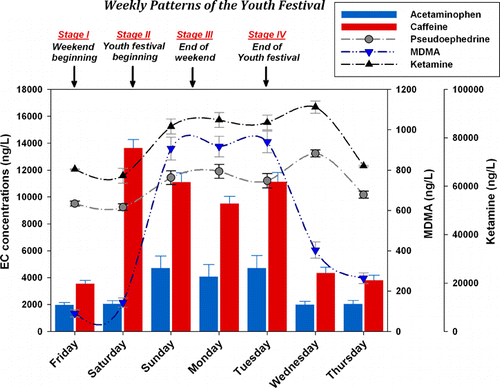Levels of 'Molly,' aka ecstasy, spike in rivers near music festival

The illicit drug called "Molly" or ecstasy is a serious concern for parents, law enforcement and now for environmentalists. Scientists report in the ACS journal Environmental Science & Technology that a major music festival in Taiwan coincides with a spike in the drug's levels in nearby rivers. Not only does this highlight drug abuse at the concert, but the scientists say it also focuses attention on potential effects the substance could have on aquatic life.
Chon-Lin Lee and colleagues explain that scientists around the world have been studying a number of substances grouped together as "emerging contaminants." These include recreational drugs, pharmaceuticals and personal care products that end up going down the drain. Wastewater treatment plants are not set up to remove them efficiently, so they get into soil and water. Some have been shown to affect the behavior of fish and to have other adverse effects on the environment. Researchers are now starting to examine the timing of contaminant spikes in waterways and sewage—for example, during Super Bowl weekend in the U.S.—to help figure out how to address them. Lee's team wanted to see how "Spring Scream," an event that attracts 600,000 music fans to a beach town in Taiwan, fit into this picture.
In addition to a jump in levels of Molly, the researchers found that concentrations of ketamine (a controlled substance), caffeine, acetaminophen and other contaminants increased in rivers near the festival. Some of these have been found to pose a moderate to high risk to aquatic plants and animals. The scientists conclude that drug abuse and its environmental effects are a growing concern.
More information: "Impacts of Emerging Contaminants on Surrounding Aquatic Environment from a Youth Festival" Environ. Sci. Technol., Article ASAP. DOI: 10.1021/es503944e
Abstract
The youth festival as we refer to Spring Scream, a large-scale pop music festival, is notorious for the problems of drug abuse and addiction. The origin, temporal magnitudes, potential risks and mass inputs of emerging contaminants (ECs) were investigated. Thirty targeted ECs were analyzed by solid-phase extraction and liquid chromatography coupled to tandem mass spectrometry (SPE-LC-MS/MS). Sampling strategy was designed to characterize EC behavior in different stages (before and after the youth festival), based on multivariate data analysis to explore the contributions of contaminants from normal condition to the youth festival. Wastewater influents and effluents were collected during the youth festival (approximately 600 000 pop music fans and youth participated). Surrounding river waters are also sampled to illustrate the touristic impacts during peak season and off-season. Seasonal variations were observed, with the highest concentrations in April (Spring Scream) and the lowest in October (off-season). Acetaminophen, diclofenac, codeine, ampicillin, tetracycline, erythromycin-H2O, and gemfibrozil have significant pollution risk quotients (RQs > 1), indicating ecotoxicological concerns. Principal component analysis (PCA) and weekly patterns provide a perspective in assessing the touristic impacts and address the dramatic changes in visitor population and drug consumption. The highest mass loads discharged into the aquatic ecosystem corresponded to illicit drugs/controlled substances such as ketamine and MDMA, indicating the high consumption of ecstasy during Spring Scream.
Journal information: Environmental Science & Technology
Provided by American Chemical Society



















